In one sentence Seele aims to restructure the future of distributed networks by developing a suite of specific transport protocols, mechanisms and architectures specifically for blockchains or in this case a “Heterogeneous Forest”. With so much hype and attention on blockchains at the moment it is difficult to filter through the rubbish to find high quality projects. Seele appears to tick all the boxes including a unique idea solving real world blockchain issues while providing new opportunities, a completely rethought out approach to network architecture as well as design and a high-class team comprised of academics and engineers.
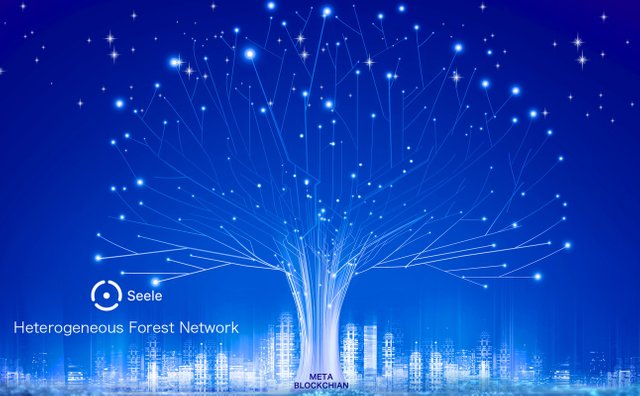
Blockchain Problems
There are many problems with existing blockchain systems, this is expected considering Bitcoin (Blockchain 1.0) was released only 9 years ago to a small community of crypto wizards. Since then much has changed and expanded especially in the last two years. However, with such rapid growth of a new technology as was the case with the internet it’s inevitable we’d run into a few problems.
If you’ve used Bitcoin or Ethereum recently (as of Jan 18) you’d know these two networks have been fluctuating around capacity for some time due to the massive increase in participants over 2017. The rapid growth caught both networks by surprise and has left participants dissatisfied with the current networks although without suitable alternatives. Granted Bitcoin did release the lightning network in Jan 2018 and Ethereum has sharding in the pipeline however to date both networks still struggle at times despite their relatively low TPS when compared to traditional requirements.
The problem stems from the three pillars of consensus algorithms and technology projects in general that is: Scalability, Security and Efficiency. It is relatively easy although still no small feat to develop something that satisfies two out of the three requirements but it is extremely difficult to satisfy all three at once due to the contradictory nature of each in themselves. Seele claims to do just this. This is a big claim but if it comes to life there is no competition.
Stemming from this issue is the fact that today’s blockchains need to compromise on one of these three aspects meaning that their use case and flexibility is therefore also compromised. Sure, Ethereum has a Turing complete language but the network itself is not suited to many business cases and also lacks flexibility. Add to this the need for blockchain interoperability in a large and scalable manner to support real world use cases, yes atomic swaps can solve this but implementation at current is lacking. We are starting to see more and more projects try and offer solutions to these problems but we are yet to see one which solves them all while also offering new opportunities for business to adopt blockchain networks. It’s not all about solving problems, you need to offer new opportunities as well!
Seele’s Solutions
Seele means soul in German, an interesting name but a memorable one none the less. As mentioned in their whitepaper Seele aims to be the soul of the new value internet. It intends to model the workings and protocols of the internet to formulate a new network where assets and data can be shared in a trustless environment, more so than just a blockchain network which still uses legacy internet protocols to make do. Seele proposes a long list of technologies which it believes will solve the aforementioned issues and provide the new standard for trustless value transfer.
One aspect I really like about Seele’s approach is that they have designed it by modelling the most efficient real world “distributed network”, the human brain. Billions of individual neurons firing, sending signals and communicating together in a trustless distributed system that satisfies Scalability, Security and Efficiency.
In my mind it’s a perfect way to model the next generation blockchain and I believe this approach will continue to be adopted in the future for network design in general. At a high level you could argue this already has taken place. While this approach is unique and I believe holds much potential to unlocking the true benefits of blockchain and distributed networks it still doesn’t change the fact that it’s easier said than done.
Seele aims to solve today’s blockchain woes by building from the ground up where not only the blockchain layer is developed but also the network architectures, consensus algorithm, coommunication and transport protocols. This ensures each component used within the network at all points of communication and transfer are designed specifically for that job in blockchains removing bottlenecks of legacy systems.
Here are the main innovations of Seele:
Neural Consensus Protocol
Consensus algorithms are at the heart of a blockchain network, they allow the trustless exchange of value and ensure network stability and security. As of current there are different methods of consensus from PoW, PoS, and DAG structures. However, as mentioned before they usually suffer from the scalability, security and efficiency issues. This is why we see varying methods of consensus used in varying blockchains with differing purposes. Due to the issue of trying to satisfy all three requirements as best as possible we have seen multiple sub type algorithms such as DPoS and hybrid PoW/PoS. However, each still has their own flaws in satisfying these requirements in one way or another.
Seele proposes the use of a new algorithm which it names the Neural Consensus Algorithm, ε-differential agreement (EDA). At a high level this method processes continual requests in an asynchronous manner. Continuous voting is used to determine consensus by utilising a convergence function which decides the votes are consistent when the compressed values of these are in a range smaller than the preset threshold in ε, this function ensures only one block is selected as the true and final block.
To determine the order of blocks most other algorthims use a Merkle tree hash function which utilises the hash from the previous block in hashing the new block so each is cryptographically linked. While this ensures consensus and immutability of past blocks it is also generally slow and adds to the bottleneck of existing systems. There are ways around this by increasing block size or decreasing transaction size but they are short term fixes for the most part as the design of this method itself is not highly scalable. Seele proposes the use of a virtual axis to determine block order rather than using the previous blocks hash. This removes the bottleneck of existing systems and allows parallel consensus.
What we see with this proposed structure is something very unique in consensus algorithms, the larger the number of nodes the faster the network is. It is usually the opposite for other networks as the larger and more geographically widespread nodes are the longer it takes for each to reach consensus due to bandwidth limitations. Seele does not suffer from this problem, it actually gets faster when more nodes join in.
The issue with new consensus algorithms is generally the lack of testing and therefore uncertainty of security. This is also the case in PoW hashing algorithms where new networks are susceptible to attack due to their low hash power. Seele covers their analysis of common attacks in the whitepaper.
A network is somewhat like a living organism, it adjusts, adapts, grows and shrinks. This means consensus algorithms need to be adaptable in order to continue to provide consensus during times of fluctuating node size and volume. Bitcoin adjusts its difficulty rate depending on hash power to keep a stable block time rate of roughly 10min.
Seele also uses variables to keep the algorithm adjusting to the continual changing dynamics of public networks. Parameters such as the convergence interval and node sampling size are adjusted dynamically to maintain network stability and security as the number of nodes grow. These together also increase the fault tolerance from 33% experienced in traditional pBFT to 40% in Seele, any bump in fault tolerance is good to see especially where critical business use case is concerned.
Common weaknesses such as the Sybil attack where malicious nodes appear as honest but are instead colluding together are threats to any peer to peer network. Seele defends against Sybil attacks by using a weighting system tied to the coin value held by each node, as long as no one node holds greater than half of the total token value then this is not possible. Due to this weight placed on account balance it makes a Sybil attack not worth pursuing. Another defence is the voting selection method, it is entirely random and thus it’s not possible for an attacker to know which node will be selected ahead of time.
Heterogeneous Forest Network
The chain structure itself is completely reworked in Seele with the aim of high scalability and flexibility. Single chain structures which Bitcoin and Ethereum function on have obvious limitations such as transaction speed bottlenecks, chain resource hogging and limited ability to natively swap value cross chain. With clear bottlenecks, solutions have sprung up in the form of parallel and side chains however these have their own limitations and generally still leave the main chain as a potential bottleneck.
Seele has decided to design a completely new architecture which it calls the Heterogeneous Forest Network. They have based the design principle off of how DNS works with the internet, multiple individual entities are all connected together through a unified naming system. Quite an ingenious solution to network architecture and the benefits are clear. It provides ultimate flexibility while also enabling unified communication and value transfer. With this approach it’s clear Seele is focused on developing a network suited to solving real world business problems.
The overall design is simple but effective, a top level “Meta chain” as Seele labels it will provide configuration and scheduling on a global level. Beneath the meta chain will sit layers of varying chains each suited to a particular business use case and scenario. Each of these can set their own governance parameters enabling complete flexibility for multiple use cases. Tasks and resources are scheduled by dividing the blockchain up into different domains based on factors such as cost, performance and security required, providing strong flexibility for users. You can see in the figure below how from a visual standpoint the network can function as individual entities yet still reap the benefits of being part of a distributed network.
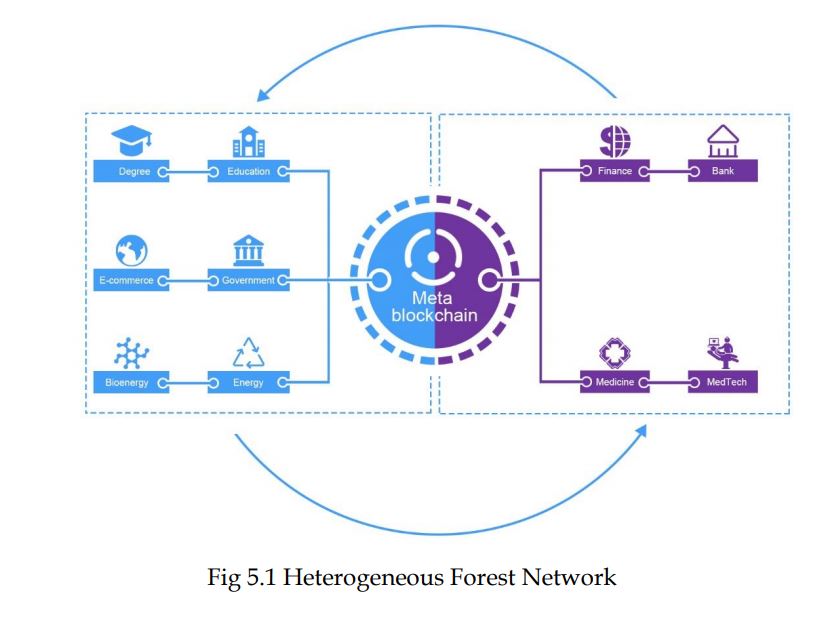
Value Transport Protocol (VTP) and Value-Chain HTTP (VHTTP)
As the names suggest Seele proposes to develop new protocols specifically designed for cross blockchain value transfers, resource identification and application access. VTP or Value Transfer Protocol (VTP) builds on top of the fundamental internet standard protocol for file transfers (FTP) to enable value transfers between blockchains. One clear issue with existing blockchains is the inability to do cross chain swaps on chain and the inefficiencies involved with this.
VTP aims to solve this by setting a communication standard and implementing it within the Seele network.
This will allow the multiple business chains to communicate and transport value between each other seamlessly. Part of this is the Uniform Asset Identifier (UAI) which is a naming convention used to set human readable names to assets on chain. Below is an example of how this works to identify assets much like the web does using an address followed by a series of namespaces and definitions or “folders” as on a web server. The initial CHAIN:// is the default protocol header, edu.pku.cs represents the particular chain identifiers and in this case /account/data can represent some piece of data associated to a certain account.
CHAIN://edu.pku.cs/account/data
VHTTP or Value Hyper Text Transport Protocol emulates HTTP, the standard protocol for the internet and like VTP aims to set protocol standards for blockchain networks. This facilitates easy cross chain asset access for applications by using a request format suited to Seele’s network utilising UAI to identify assets. Seele will provide three request methods for applications to use, the standard GET and POST as well as TRANSFER which as the name suggests will facilitate the transfer of assets between two identities. VHTTP is backwards compatible with HTTP so outside off chain users can access assets using standard means.
Both these protocols are a good step for blockchain technology and expand the use cases beyond what has been seen so far. Their simplicity yet usefulness is exactly what is needed for blockchain adoption as it allows the creation of highly flexible applications built ontop of Seele’s network without the user necessarily realising they are using a blockchain, much to the same as other well adopted technologies.
Quick Value Internet Connection (QVIC)
Blockchains are global networks of many individual nodes each communicating over the internet using traditional TCP and UDP protocols. Both these protocols are suited to different use cases however they are somewhat on two sides of the extreme. TCP is slower due to the back and forth of confirming orders and receivables but it maintains integrity while UDP is fast as it doesn’t confirm packet orders or receivables however you’ve more than likely missed a few packets during the process. Both are legacy protocols for blockchains and while they work they aren’t really suited to an environment that requires the best of both worlds from TCP and UDP, ie. Fast connection between nodes across the globe and strong data integrity.
Quick Value Internet Connection (QVIC) aims to solve this by lowering latency and controlling handshaking at the sending source meaning transfer occurs directly and are verified correct. You can see below how QVIC enables a much higher speed over TCP just by removing the need to bounce back and confirm handshake status similarly to UDP however because handshake control is completed by the sender the client is able to verify integrity. QVIC will be implemented out of the box in the Seele wallet and browser.
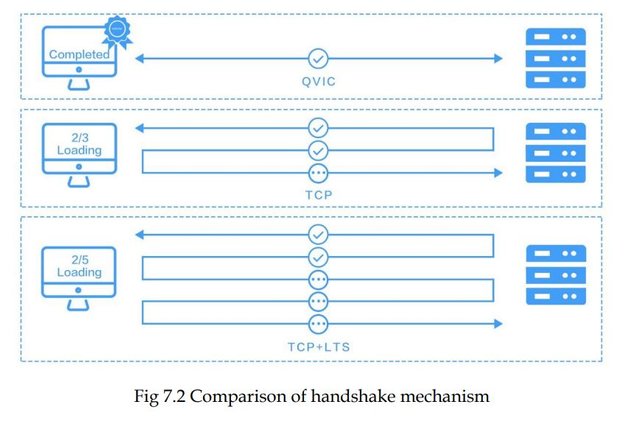
Storage
Storage on public blockchain networks is an ongoing issue due to the public trustless nature of it you run into several problems, namely privacy and capacity. This makes it not viable for most big business and government use cases where large data stores are kept and need to be accessed and transferred. Seele will incorporate both on chain and off chain storage as a means to solve this utilising IPFS for off chain storage and Naming Value Transfer Protocol (NVTP) to identify with on chain resources. Data to be stored is first uploaded to the blockchain, hashed and then the data is copied to IPFS storage. When it needs to be retrieved the hash is provided which searches the network for the node in which it is stored and then it’s sent back to the user.
Seele will extend Meta-Data-Directory Specification (MDDS) to a proposed Resource Description Framework (RDF). RDF will be used to not only describe data resources as with MDDS it will also add description of associated computing resources. These are used to identify with resources and assets either on chain or off and map between the two.
When data is to be executed it’s sent through an encapsulated sandbox then run on the contracts virtual machine as well as on the computing resources outside the chain. This in effect protects executed business data and results by way of a sandbox environment. Seele’s VM design and sandbox environment also consequently enable compatibility with Ethereum and EOS while being highly customisable for a variety of business use cases and needs.
Use Cases
The flexibility of Seele is unmatched in any other blockchain network and competes with existing business orientated software such as Hyperledger. Essentially whatever you think could benefit from blockchain would be suited to Seele. Taking a look at their roadmap you’ll see multiple real world use case applications are set to be delivered throughout 2019 from medical data exchange to cross border trade settlements.
IoT device communication is also a perfect use case for Seele’s network due to its scalability while maintaining security. Along with the ability to perform effortless cross chain value transfers, Seele stands above other existing blockchhain’s and DAGs when it comes to IoT.
A few other examples are supply chain logistics, cross border business contracts, government services such as identity and voting, accounting/auditing and even game value.
Road Map
The Seele team have a mammoth task ahead of them, the research that has already been completed is substantial yet now they have to move past the prototype phase and into the implementation phase. This is where multiple miscellaneous issues can spawn out of nowhere and implementation bugs can halt progress.
The road map is tight but reasonable given the decent size of the team and their progress so far. The mainnet will be available in about Q3 of 2018 according their FAQ page and in Q4 we’ll see the release of the wallet and browser. V1 is set to launch in Q1 of 2019, after this the Seele team will focus on developing and integrating services.
Next year looks to be jam packed with real world practical service releases from medical data exchange in Q1, cross border trade settlements in Q2, car network communication in Q3 and IoT applications in Q4 alongside v2 release. It will be interesting to see how the Seele team progresses through the roadmap and how well they manage to keep to
schedule.

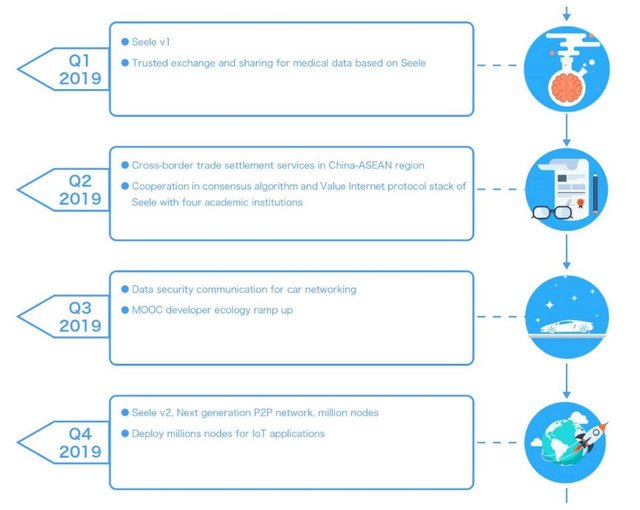
Team
As ICOs are generally either whitepaper only or basic proof of concept a strong team is an absolute must when choosing where to invest. Seele especially considering the wide array of technologies they wish to develop.
With 4 PhD researchers and 8 blockchain engineers/architects I think they are well equipped to tackle the tasks at hand although it won’t be easy. They also have a strong net of advisors both technical and market. Chief Scientist Dr Wei also holds 8 blockchain related patents and boasts connections from Oxford and City Uni London.
My only gripe is the lack of direct blockchain development experience on the dev team, although this being such a new industry blockchain development experience is very hard to come by. I will say though that a good software engineer/architect can build anything, it’s more so the problem-solving mindset than the technical skills that are important as technical skills can be learned but a good problem-solving thought pattern is more difficult to master. With that in mind the dev team are more than capable with years of engineering experience in large companies such as Baidu working with big data, protocol design and network architectures, exactly what Seele aims to do.
The institutional connections behind Seele are also a strong point with the likes of Stanford, UCLA and Oxford in research collaboration. The sheer leverage these institutions can bring is huge and adds to the strength of Seele’s team. The extent to which this collaboration entails is unknown yet the background of the team shows they more than likely have multiple connections at these institutes as they have received qualifications from them. The roadmap in 2019 also gives a hint to Seele working with several institutions.

Only half of the core team
Token Sale
There is not much information available on the token as of yet, this will be released after the whitelist and I will update any details as they are made public. They have released their distribution chart with a total supply of 1 billion tokens. 48.25% of which will be available on public sale and 30% kept for mining rewards when the network goes live. Miners will be rewarded based on their contribution to the network such as the number of blocks produced and resource
The team, early investors and foundation will take 20% in total together with 7% for the team, 10% foundation and 3% early investors. Overall a very fair amount distributed between the team and public with a reasonable amount left for mining rewards. We still need to get eth price ratio in order to calculate potential market cap and the intended soft and hard caps for the public sale so I will update once this is public.
Seele intends to hold their ICO with an ERC20 token which will then be mapped to the mainnet when released.
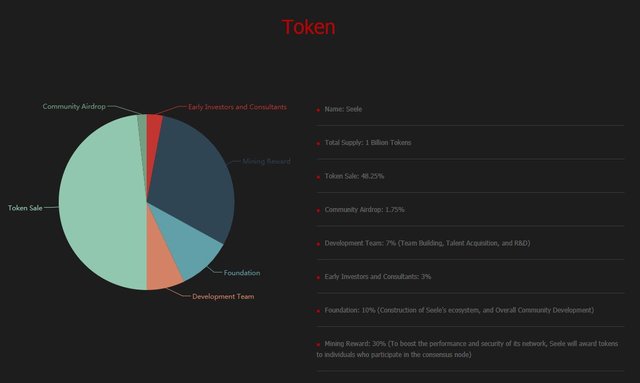
Final Thoughts
While this is not an extensive list or review of what Seele aims to do I have for the most part covered the main points and innovations behind Seele. I have high hopes for the project long term, I believe there is no other project that compares with the breadth and impact Seele aims to achieve. The vision is clear and appeals to a very wide market, Seele could be that network that boosts blockchain’s acceptance into the real world business use cases.
It has the ability to bring it to the mainstream and provide the capability for businesses and startups to leverage a technology that will provide a wide range of benefits without users even knowing they are using a blockchain. As at current blockchains are a tech geek crowd with command line compiling and barebones interfaces, far from what the average person would go near.
The ground up development approach for Seele is unique in that it tries to remove any and all possible bottlenecks from existing legacy internet protocols and blockchains. Built from the ground up for a completely new type of network ecosystem. Even unreleased next gen blockchains such as EOS sit behind Seele in my opinion.
The above is all my own personal opinion and understanding of Seele’s implementation. If there is something incorrect please let me know. What are your thoughts on Seele?
Coins mentioned in post:
Downvoting a post can decrease pending rewards and make it less visible. Common reasons:
Submit